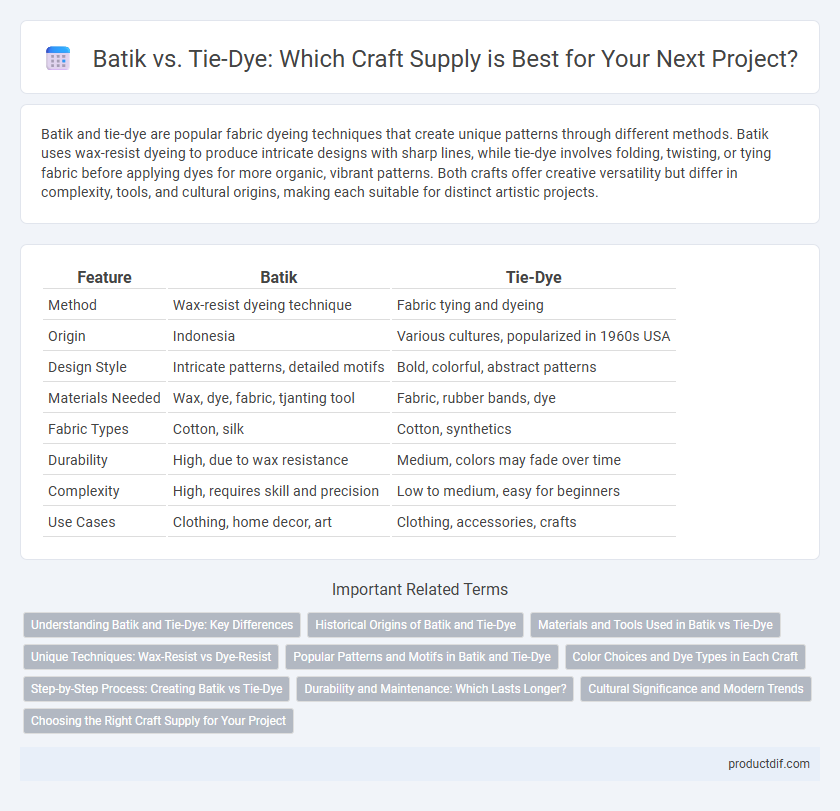Batik and tie-dye are popular fabric dyeing techniques that create unique patterns through different methods. Batik uses wax-resist dyeing to produce intricate designs with sharp lines, while tie-dye involves folding, twisting, or tying fabric before applying dyes for more organic, vibrant patterns. Both crafts offer creative versatility but differ in complexity, tools, and cultural origins, making each suitable for distinct artistic projects.
Table of Comparison
| Feature | Batik | Tie-Dye |
|---|---|---|
| Method | Wax-resist dyeing technique | Fabric tying and dyeing |
| Origin | Indonesia | Various cultures, popularized in 1960s USA |
| Design Style | Intricate patterns, detailed motifs | Bold, colorful, abstract patterns |
| Materials Needed | Wax, dye, fabric, tjanting tool | Fabric, rubber bands, dye |
| Fabric Types | Cotton, silk | Cotton, synthetics |
| Durability | High, due to wax resistance | Medium, colors may fade over time |
| Complexity | High, requires skill and precision | Low to medium, easy for beginners |
| Use Cases | Clothing, home decor, art | Clothing, accessories, crafts |
Understanding Batik and Tie-Dye: Key Differences
Batik involves applying wax to fabric before dyeing, creating intricate, often geometric patterns where the wax resists the dye, resulting in detailed, crisp designs. Tie-dye uses folding, twisting, or crumpling fabric, securing it with rubber bands, and applying dye to produce vibrant, abstract, and colorful patterns with characteristic circular or spiral shapes. The key difference lies in Batik's wax-resist technique for precise motifs versus Tie-dye's manual binding method for spontaneous, multi-hued effects.
Historical Origins of Batik and Tie-Dye
Batik originated in Indonesia over a thousand years ago, where artisans used wax-resist dyeing techniques to create intricate patterns on fabric, deeply rooted in Javanese culture. Tie-dye has ancient origins as well, with evidence dating back to Asia and Africa, employing manual folding, twisting, or binding to produce colorful, random patterns. Both crafts highlight unique historical and cultural craftsmanship methods, distinguishing Batik's precision from Tie-dye's spontaneous designs.
Materials and Tools Used in Batik vs Tie-Dye
Batik utilizes wax and specialized canting tools or brushes to apply hot wax on fabric, creating intricate patterns that resist dye, while tie-dye relies on rubber bands, strings, or clamps to fold and bind the fabric, producing vibrant, random colors when dipped in dye. Batik often requires cotton or silk fabrics that absorb wax and dye well, whereas tie-dye is commonly applied to cotton, rayon, or other natural fibers that soak up liquid dyes effectively. The difference in materials and tools results in Batik producing detailed, sharp designs with a wax-resist technique, contrasting with tie-dye's bold, fluid, and often multi-colored patterns formed by binding methods.
Unique Techniques: Wax-Resist vs Dye-Resist
Batik employs a wax-resist technique where hot wax is applied to fabric to create intricate patterns, preventing dye from penetrating those areas and resulting in sharp, detailed designs. Tie-dye utilizes a dye-resist method involving folding, twisting, or tying fabric with strings or rubber bands to create organic, unpredictable patterns by blocking dye in certain sections. The fundamental distinction lies in batik's use of wax as a physical barrier for precise motifs, while tie-dye relies on mechanical binding to form vibrant, spontaneous patterns.
Popular Patterns and Motifs in Batik and Tie-Dye
Batik patterns typically feature intricate, symmetrical motifs such as floral designs, geometric shapes, and traditional symbols rooted in Indonesian culture, highlighting delicate line work achieved through wax-resist dyeing. Tie-dye patterns emphasize bold, abstract, and vibrant spirals, circles, and stripes created by folding, twisting, and binding fabric before dye application, resulting in unpredictable, psychedelic effects. Both techniques showcase distinct artistic aesthetics where Batik prioritizes precision and cultural storytelling, while Tie-dye promotes spontaneity and colorful experimentation.
Color Choices and Dye Types in Each Craft
Batik employs wax-resistant dyeing techniques that allow for multiple layers of colors, often using natural dyes derived from plants and minerals to achieve rich, earthy tones. Tie-dye relies on folding and binding fabric to create vibrant, unpredictable color patterns typically using fiber-reactive or synthetic dyes known for their bright, saturated hues. The choice of dye type in Batik favors slow, controlled color application, while Tie-dye emphasizes quick absorption and bold color contrasts.
Step-by-Step Process: Creating Batik vs Tie-Dye
Creating Batik involves applying hot wax to fabric using tools like canting or brushes, followed by dyeing the cloth and removing the wax to reveal intricate resist patterns. Tie-dye requires folding, twisting, or crumpling fabric, securing it with rubber bands, and applying various dyes to create vibrant, spontaneous designs. Both techniques rely on resist dyeing but differ in precision and fabric manipulation methods.
Durability and Maintenance: Which Lasts Longer?
Batik fabrics, created using wax-resist dyeing, typically exhibit superior durability due to the wax coating that preserves the fabric's integrity and vibrant patterns through multiple washes. Tie-dye materials, often produced with direct dye application, may fade faster and require gentler handling to maintain color intensity over time. Proper care involves cold washing and avoiding harsh detergents for both techniques, but batik's intricate dyeing process generally ensures longer-lasting visual appeal and fabric strength.
Cultural Significance and Modern Trends
Batik, originating from Indonesia, holds deep cultural significance as a traditional fabric art with intricate wax-resist dyeing methods symbolizing heritage and identity. Tie-dye, popularized in the 1960s counterculture movement, reflects freedom and self-expression through vibrant, psychedelic patterns. Modern trends showcase a fusion of both techniques in fashion and home decor, emphasizing sustainability and artisanal craftsmanship.
Choosing the Right Craft Supply for Your Project
Batik uses wax-resist dyeing techniques to create intricate, detailed patterns ideal for precise designs, while tie-dye produces vibrant, random color blends perfect for bold, abstract styles. Selecting the appropriate fabric dye, wax, and tools tailored to your chosen method ensures optimal results and durability. Understanding the differences in materials and processes between batik and tie-dye helps crafters achieve their desired artistic effect efficiently.
Batik vs Tie-dye Infographic

 productdif.com
productdif.com